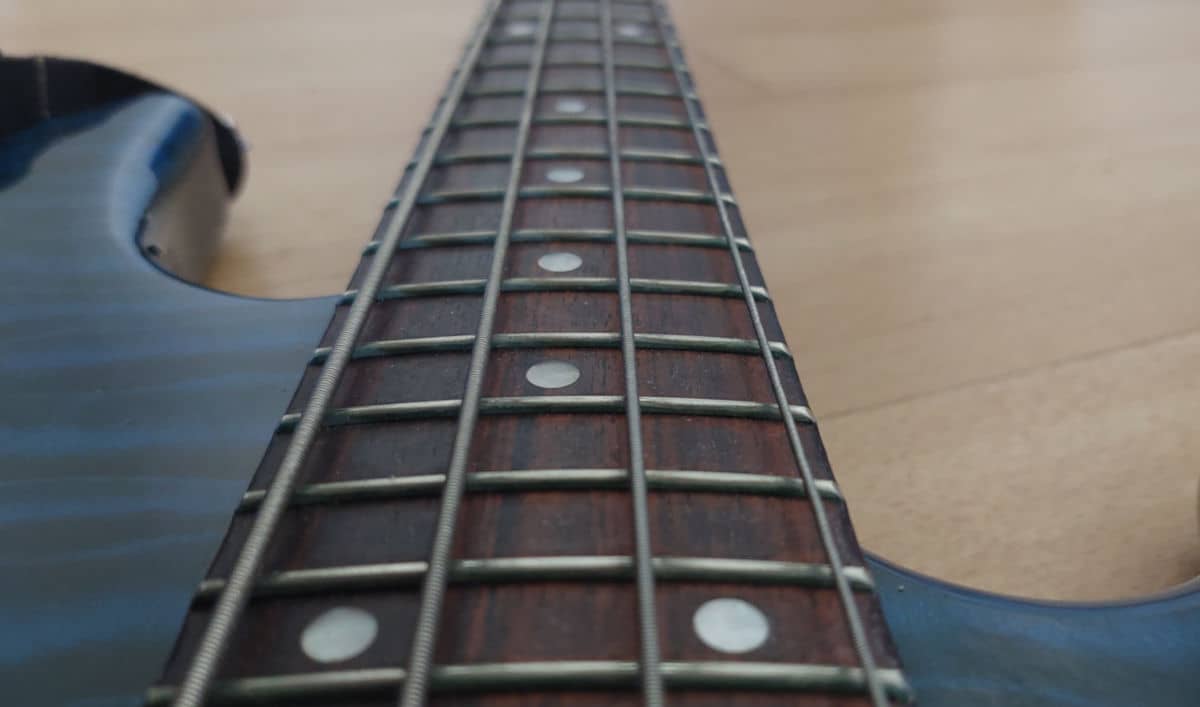Lately, I`ve seen the topic of how many frets a bass should have come up. The first Precision bass only had 20, but modern basses tend to have 20, 21, 22, or 24. So how many frets are enough, and do you need 24 frets on a bass?
24 frets are only needed on the bass in exceptionally rare cases. The extra high reach can help in playing solos and high chords. However, even melodic players who use 24 frets utilize them infrequently, and the extra range is not a necessity for the majority of bassists.
I`ve mainly played basses with 24 frets myself. The extra range has proven to be helpful when experimenting and jamming. However, I am yet to play anything above the 20th fret in a band setting, despite playing a lot of melodic lines.
Then again, I’ve also met bassists who love having the extra range, some of whom have even utilized it well within a band.
So how many frets will be enough for you, and what should you be mindful of when considering fret count?
How many frets does a bass need?
In general, bassists don’t need more than 20 frets on the bass. The 9 first frets are enough to play the majority of deep bass lines. For melodic and solo play it is common to only use 14-16 frets at most.
When considering the need for frets, remember that the common bass is a 4-string instrument for a reason. If there was a need for a higher range, an additional string could be added.
Melodic lines also generally have some deep end to them and tend to not be played too far up the neck. For solo play, it is common to move higher up. However, a 4-string bass with 20 frets is still enough for this purpose in most cases.
The bass guitar also starts to sound thin when played at its upper range. As a result, it is common for bassists to stick to the lower ranges.
Thus, most bass guitars have 20-24 frets, as this is more than sufficient in most cases.
However, you will need more frets if you are looking to cover or emulate artists that have utilized 21 or more. If you are inspired by melodic players that have made use of the high reach that additional frets offer, you could feel limited by not having the same range as them.
Playing at or above the 21st fret can also be something that you’d like to do for any odd reason at some point. It could just be a single note or part in a song your band writes or that you cover.
Chances are good that this will never happen, but you’ll want to have enough frets if it ever does. Having additional frets also doesn’t have any downside to it, so it does no harm in having a bass with frets that you never end up using.
Basslines that use 24 frets
There are bassists that have made great use of the full range of 24-fret basses.
An example of this is Justin Chancellor`s bass lines, as he has used the full range of the bass multiple times. For example, in Tool`s song “10000 days pt. 2” he plays a beautiful chord progression that uses the 24th fret.
On “The Pot” he uses it as part of a bass solo. Watch this great cover by CoverSolutions below to see how. The 24th fret is utilized at the 4-minute mark.
Les Claypool`s bass lines also often push the bass guitar to its boundaries. For example, on Primus` “Wynona’s Big Brown Beaver” he uses the 24th bass fret on a solo towards the end of the song.
Jesse F. Keeler of Death From Above 1979 uses the 24th fret for playing a chord progression on their song “White is Red”. The band does not have a guitar player, so the high reach works well for fulfilling the role of bass and guitar simultaneously.
While Cliff Burton’s most iconic bassline in Metallica might be “For Whom the Bell Tolls”, it only goes to the 19th fret. However, on “(Anesthesia) Pulling Teeth”, he does utilize the 24th fret in a slide towards the end of the song.
The upper reach of the bass has also been used a lot in jazz. Ron Carter and Gordon Johnson are two bassists who can regularly be found playing at the highest ranges of the bass.
Frets and scale length
The number of frets on the bass is independent of its scale length.
Therefore, a bass with 24 frets could have the same scale length as one with 20 frets or even be shorter than it.
The bass will essentially have a larger body due to having a shorter neck if it has fewer frets. However, this has little effect on the playability of the instrument, and the length of the instrument as a whole is not affected by this.
Thus, If you are looking for a smaller instrument, you should consider playing a short-scale bass, rather than a bass with fewer frets.
Conclusion
Are 20 frets enough on a bass? For most people, yes. Chances are good that you will never feel the need for a 21st fret for the entirety of your career as a bassist.
With that said, there is no reason to limit yourself. Extra frets mean more creative possibilities, and there is no harm in having more.
Thus, all things being equal I would choose a bass with more frets over one with fewer. In reality, it’s not something I would pay any mind to.
You should make sure you have enough frets if you are looking to cover or emulate artists who use the entire range of the bass. If you are writing music or playing in a band where you are regularly playing high chords, additional frets could also come in handy.
One thing that has a much bigger impact on the range of the bass than the number of frets, is how many strings it has. I have written about why the bass usually has 4 strings here. After reading the article you will know why the bass originally had 4 strings, and what drives bassists to play 5 and 6-strings.

